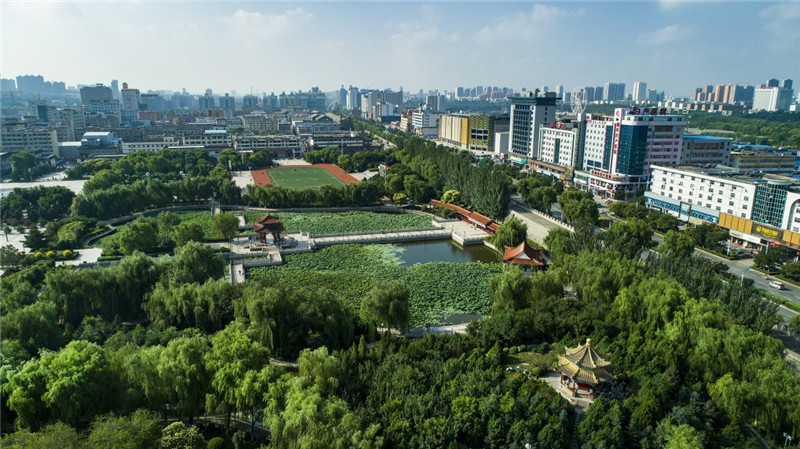Building an ecological world with language

Photo by a drone on Aug. 2 shows the tree-lined Lotus Pond Central Plaza in Yulin, Shaanxi Province, which is a demonstration city of national ecological protection and construction. Photo: XINHUA
Ecolinguistics, covering both ecological science and linguistics, mainly studies linguistic ecology and the interaction of language and environment. It not only establishes a new relationship between human beings and nature but also utilizes the full value of linguistics.
Huang Guowen, director of the School of Foreign Languages at Nanjing Agricultural University, noted that ecolinguistics embodies three main aspects, the protection of endangered languages and the languages of ethnic minorities, the role language plays in protecting the environment and improving people’s ecological awareness, and the way ecological ideas change the attitudes of people towards ecology.
“Ecolinguists believe that a language system ought to build the world ecologically,” said Fan Junjun, a research fellow from the Chinese Dialect Research Center at Jinan University. He explained that some scholars have concluded that the language environment can be divided into three levels: the biology-related logical environment, the consciousness-related logical environment and the society-related logical environment, which respectively correspond to the three levels of a human being. Ecolinguistics aims to study the interrelation between languages and the three levels, he added.
Feng Guangyi, a professor from the School of News and Communication at the South-Central University for Nationalities, said that ecolinguistics studies a series of problems in the language ecosystem, explores general laws for building a good language ecosystem, and provides ecological theories and decision-bases for the construction of an ecological civilization.
The core issue in the study of ecolinguistics is about the interaction between languages and the environment. In Feng’s view, this issue embodies not only the macro-level social features but also the micro-level features that are closely linked to objective, specific things. Research can be conducted by linguistic methods or ecological methods and studied at a macro or micro level. Additionally, synchronic study, diachronic study, qualitative analysis and quantitative analysis can also be adopted by researchers.
Fan demonstrated that foreign scholars divide the linguistic ecosystem into four parts. The first is symbolic linguistic ecology, which views interlingual or intralingual relation as a symbolic ecological environment. The second is natural ecology including terrain, climate, animals and plants. Sociocultural ecology, the third, refers to the political, cultural and historical environments of language communities. The last part is cognitive ecology, which refers to human thinking and cognition toward the world.
Huang concluded that ecolinguistics study uses three different perspectives: nature, psychology and sociology, which respectively pay close attention to the natural, the psychological and the social environments of languages.
Fan said, “The impetus and vitality of language both lie in application, so a language’s essence should be expanded and enriched in the process of social practice.” The study of ecolinguistics in the future should focus on the crisis of language ecology, and it should meet practical needs, Fan added. That is how we can strengthen empirical study and conduct a relatively macro-level or strategic study.
Huang indicated that ecolinguists are all supposed to evaluate and criticize the behaviors and thoughts of human beings and nurture people’s ecological literacy based on future language study.
In Fan’s view, scientific monitoring and evaluation are the starting point for tackling the contemporary crises of language ecology. When conducting language monitoring and evaluation, researchers should dynamically focus on the distribution of languages, their survival conditions, their development status and the diverse effects that cause language ecological change, particularly the changes in language ecological environment caused by human activities.
(edited by CHEN ALONG)
